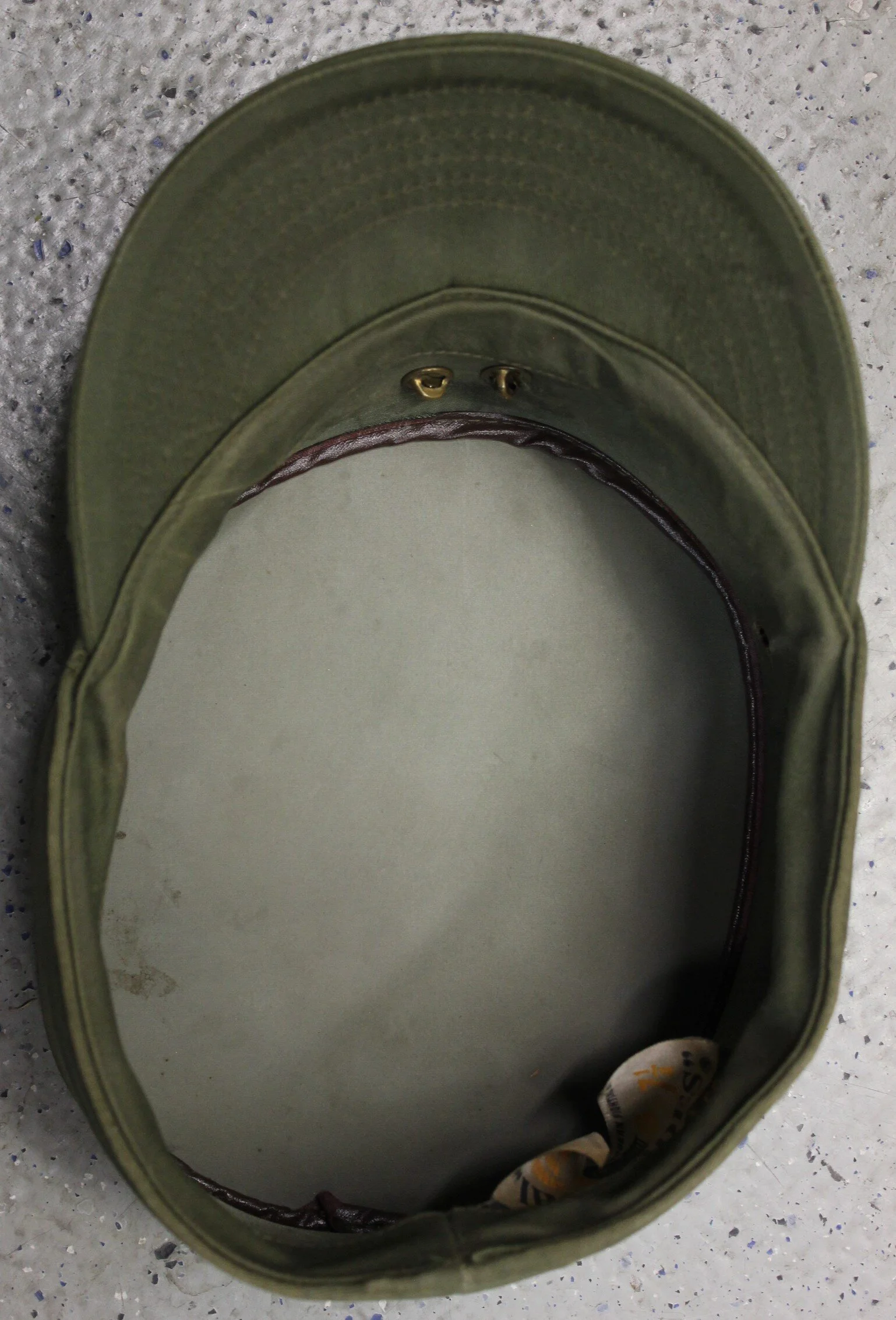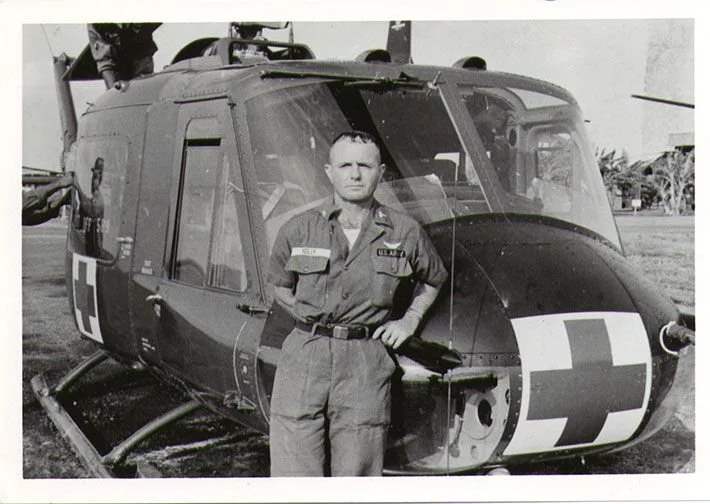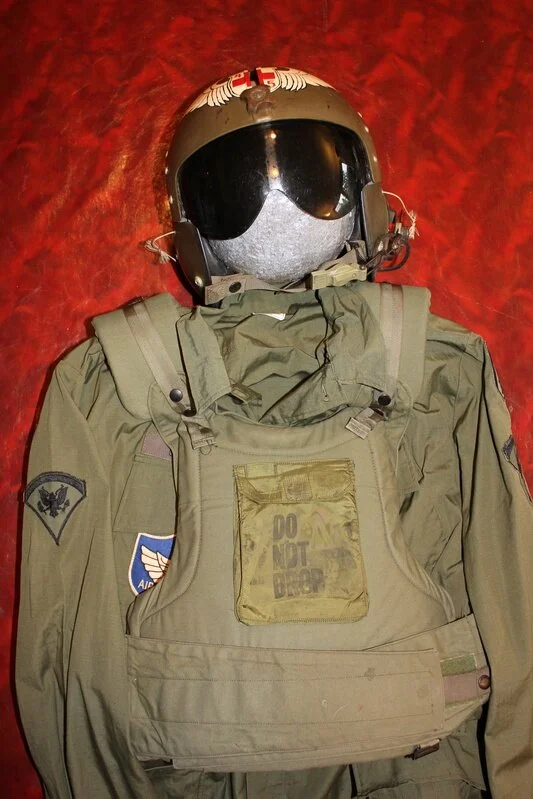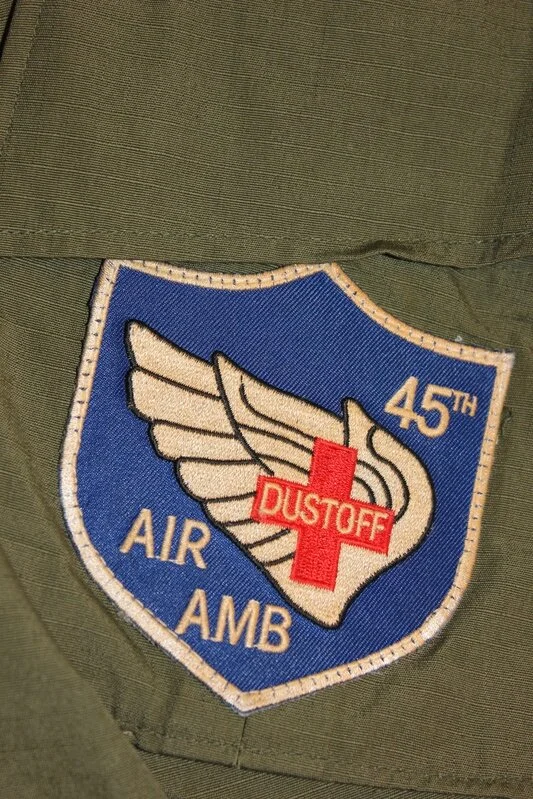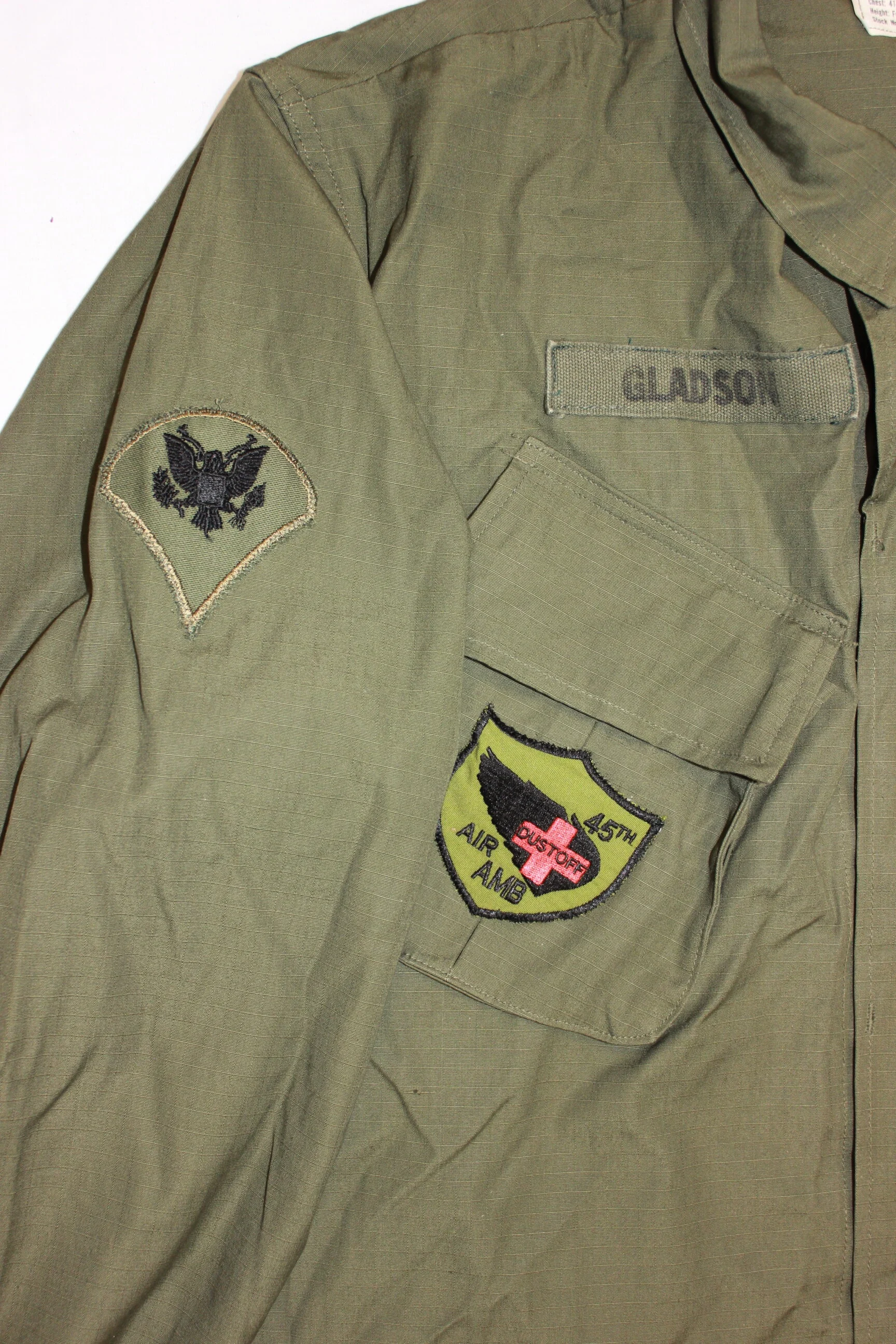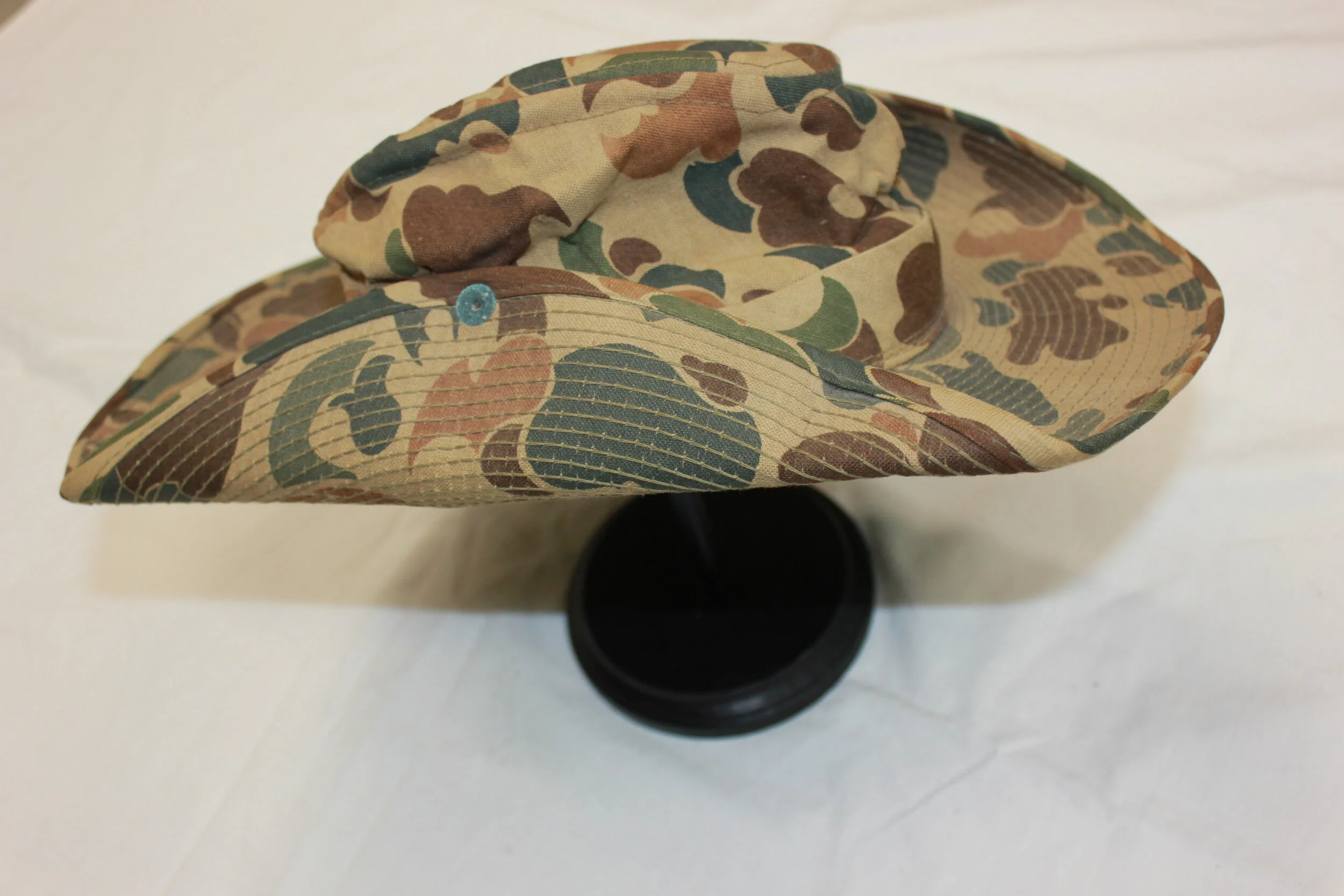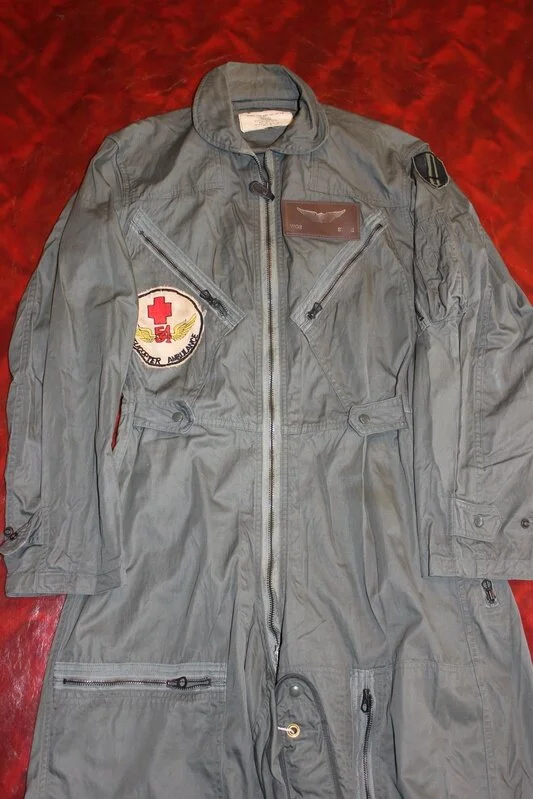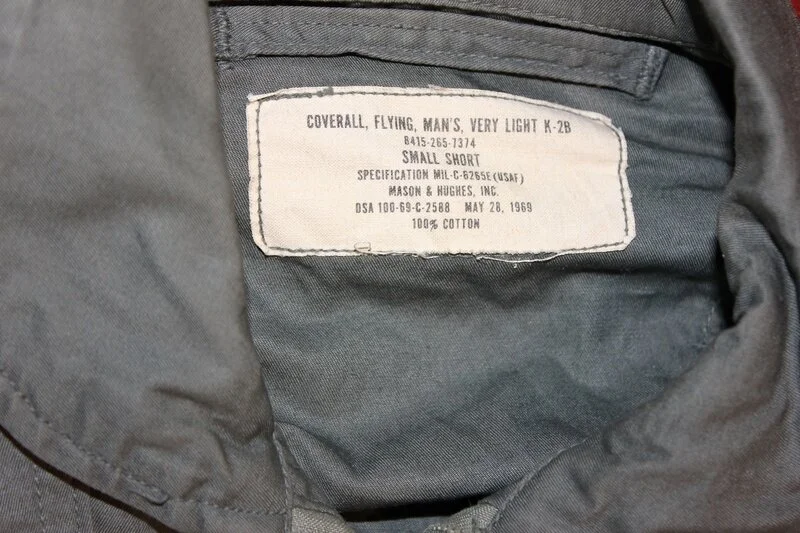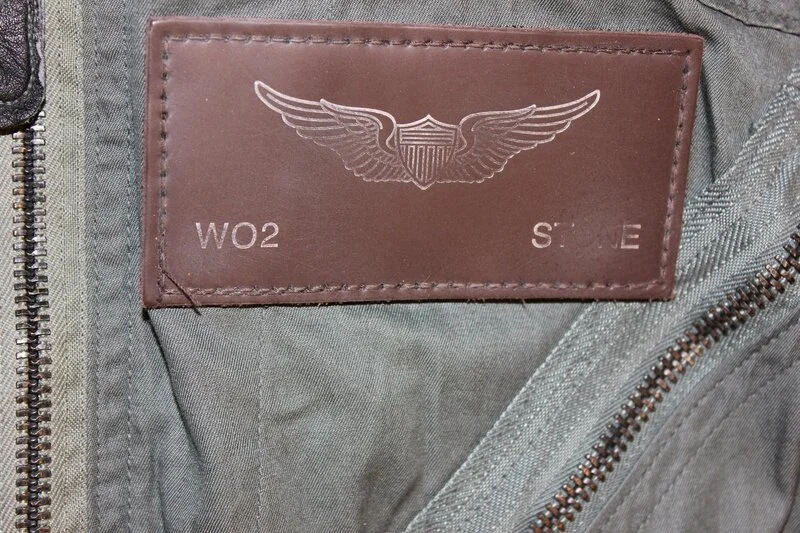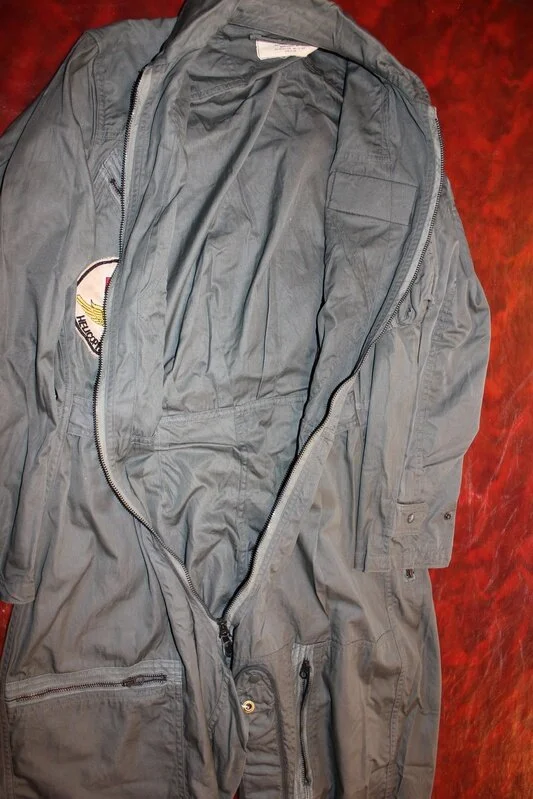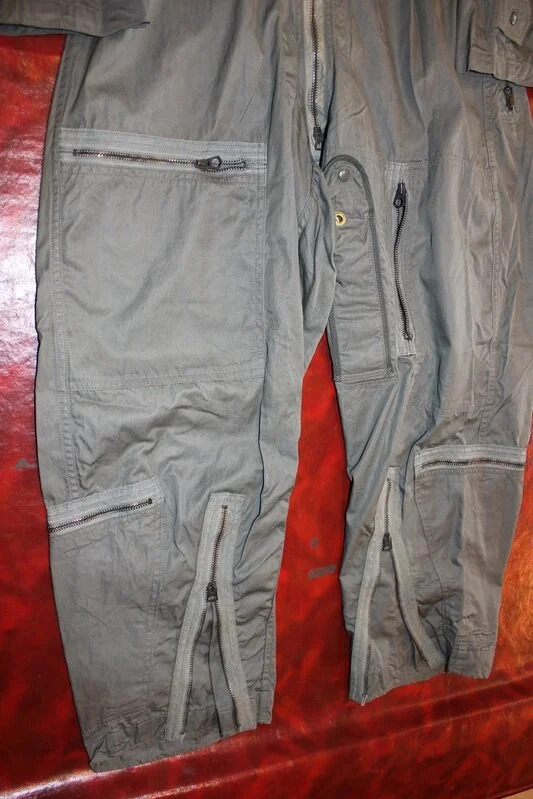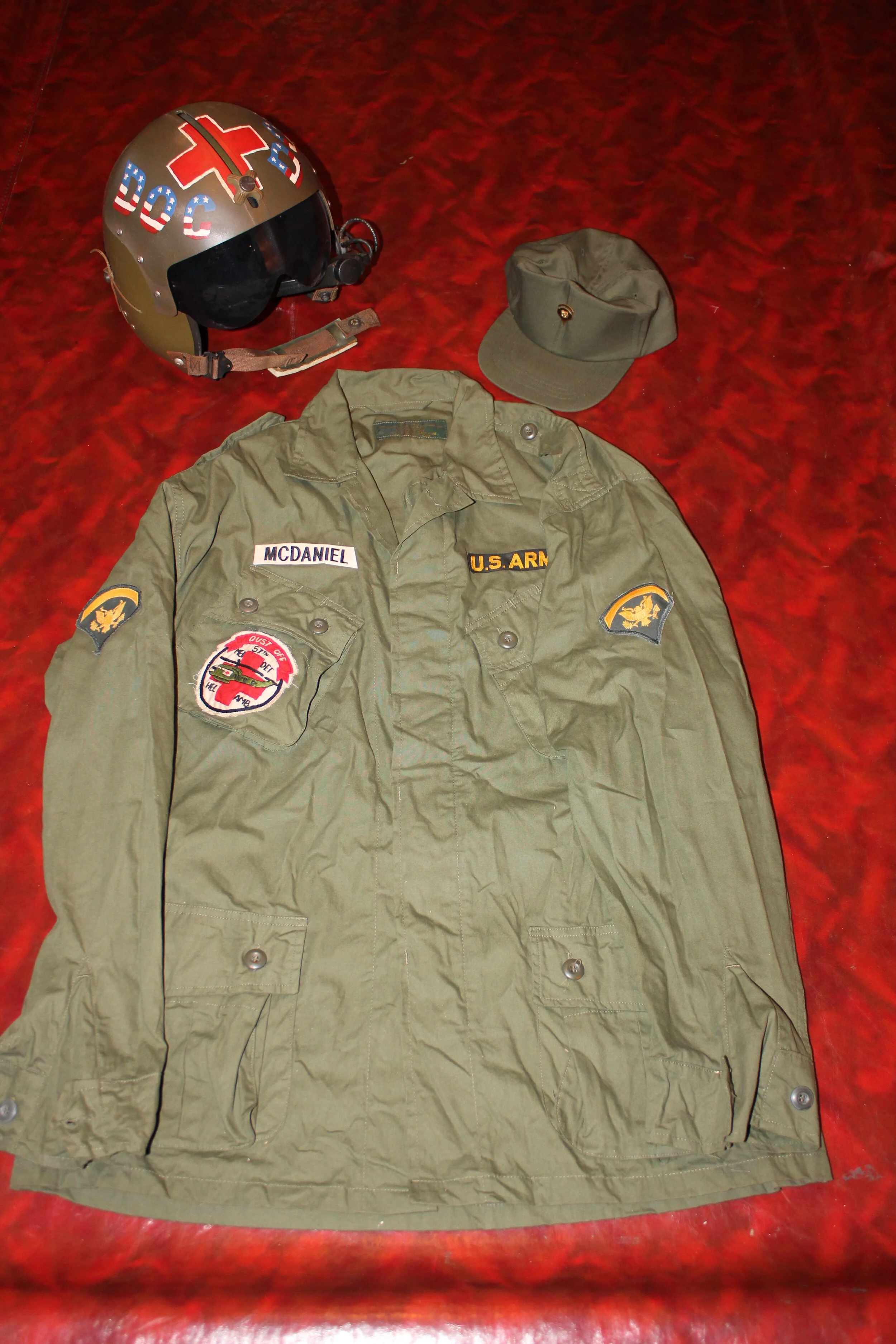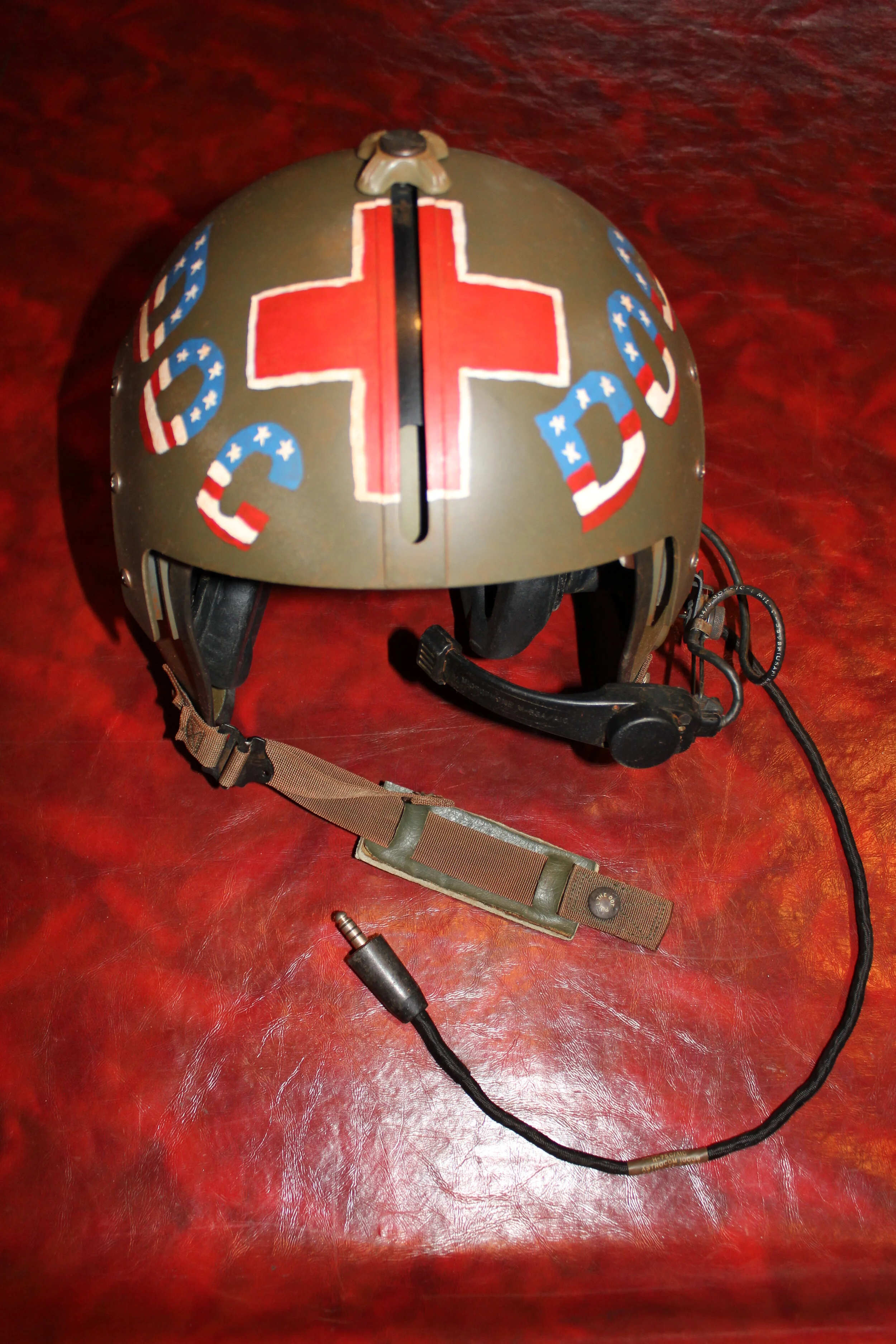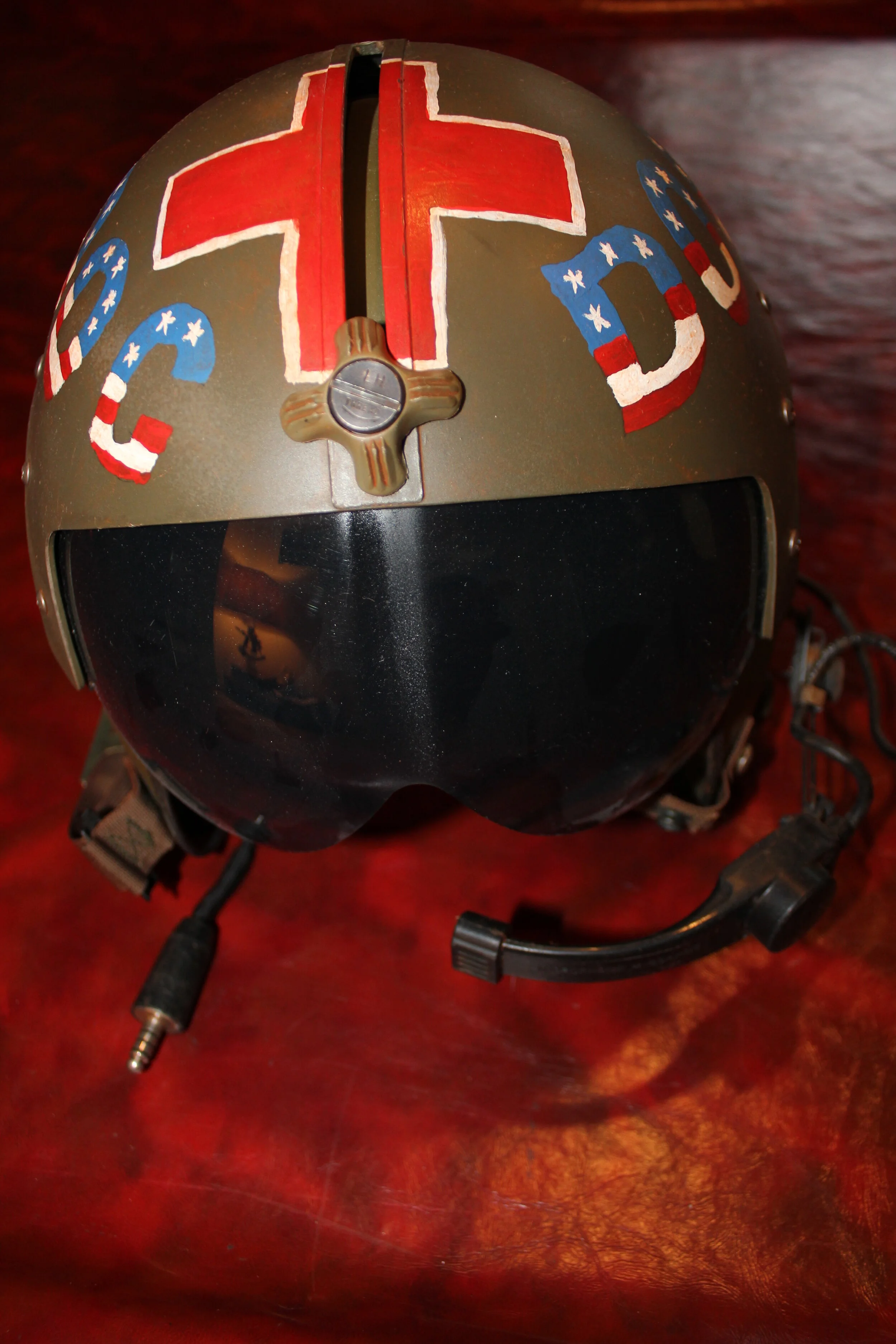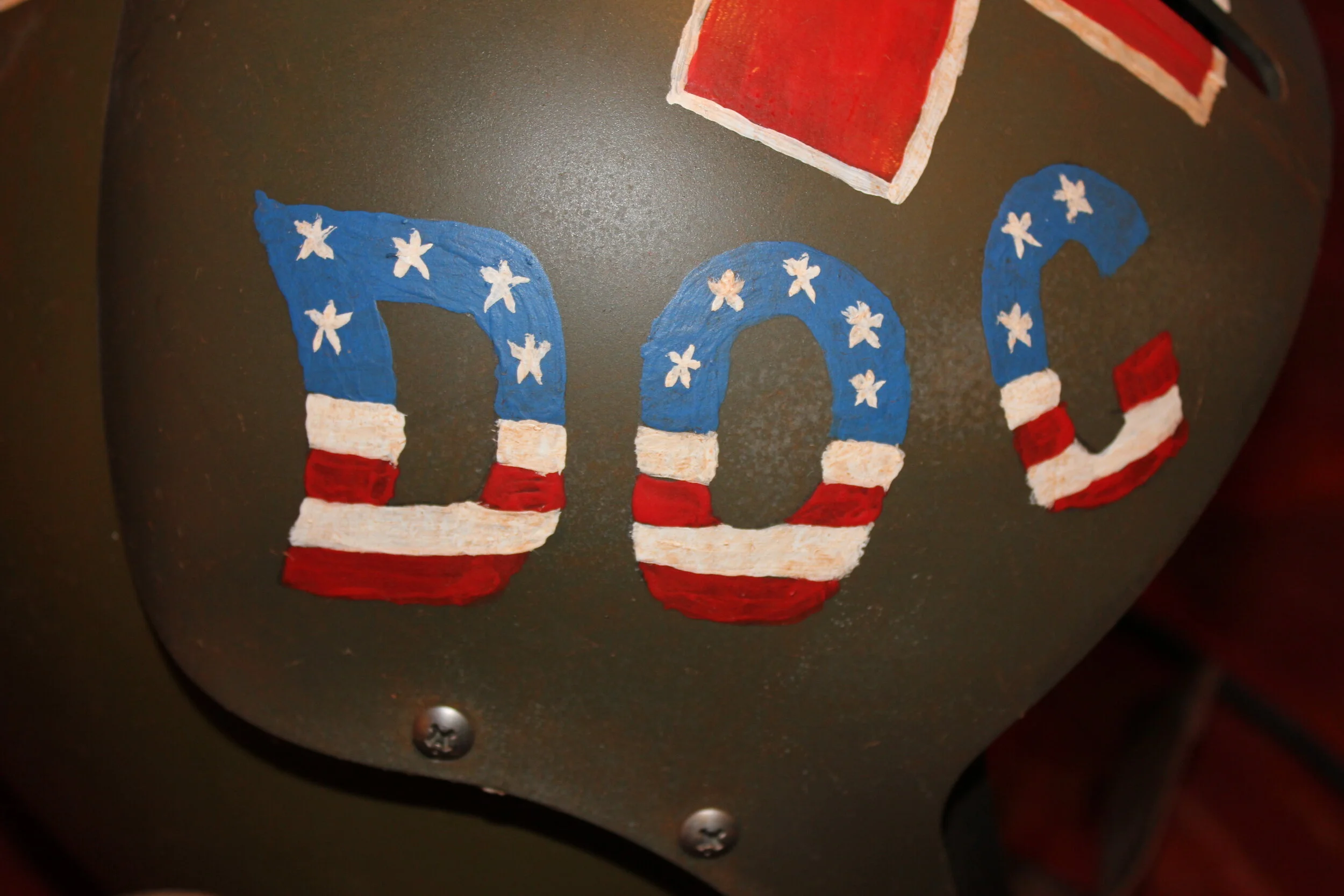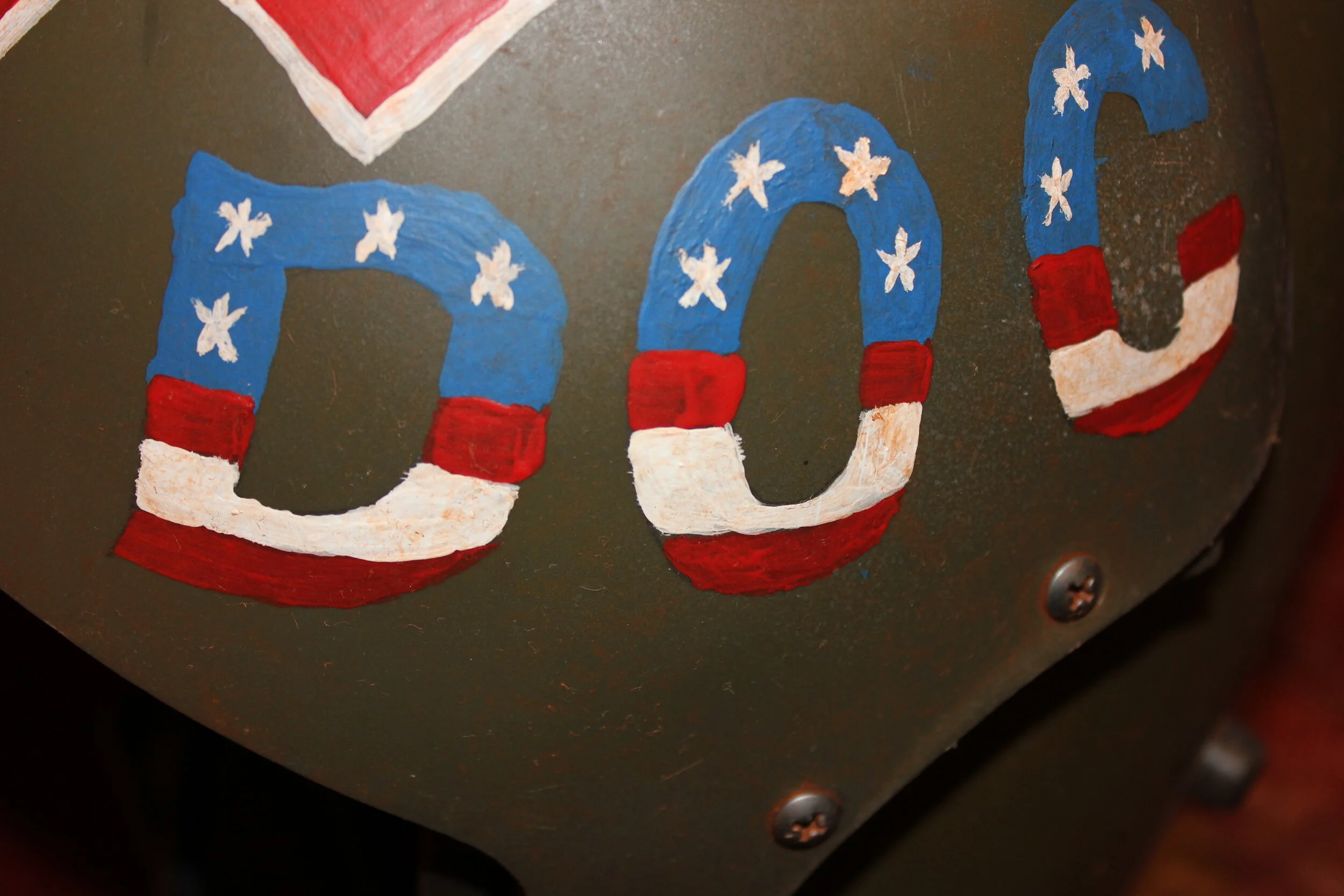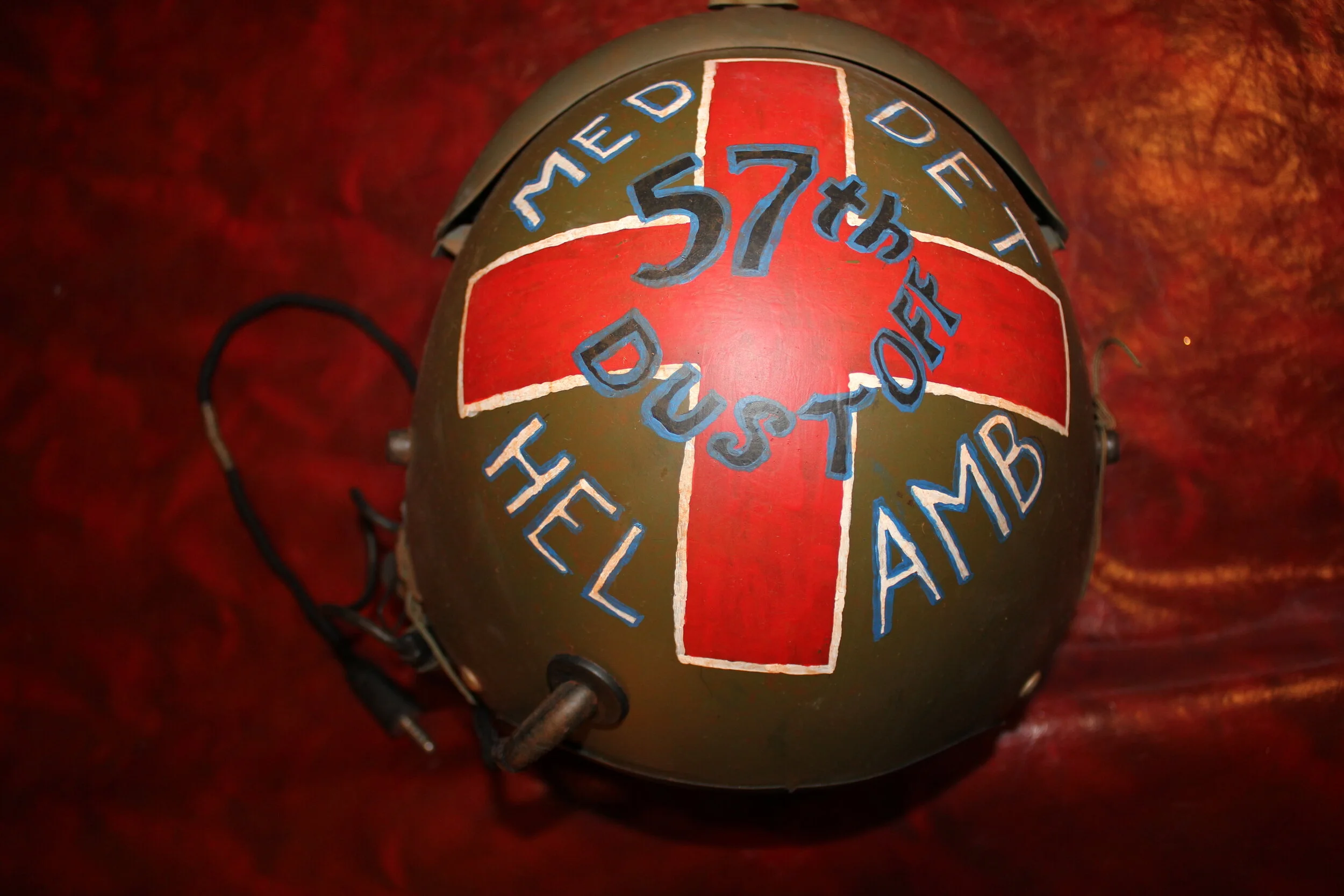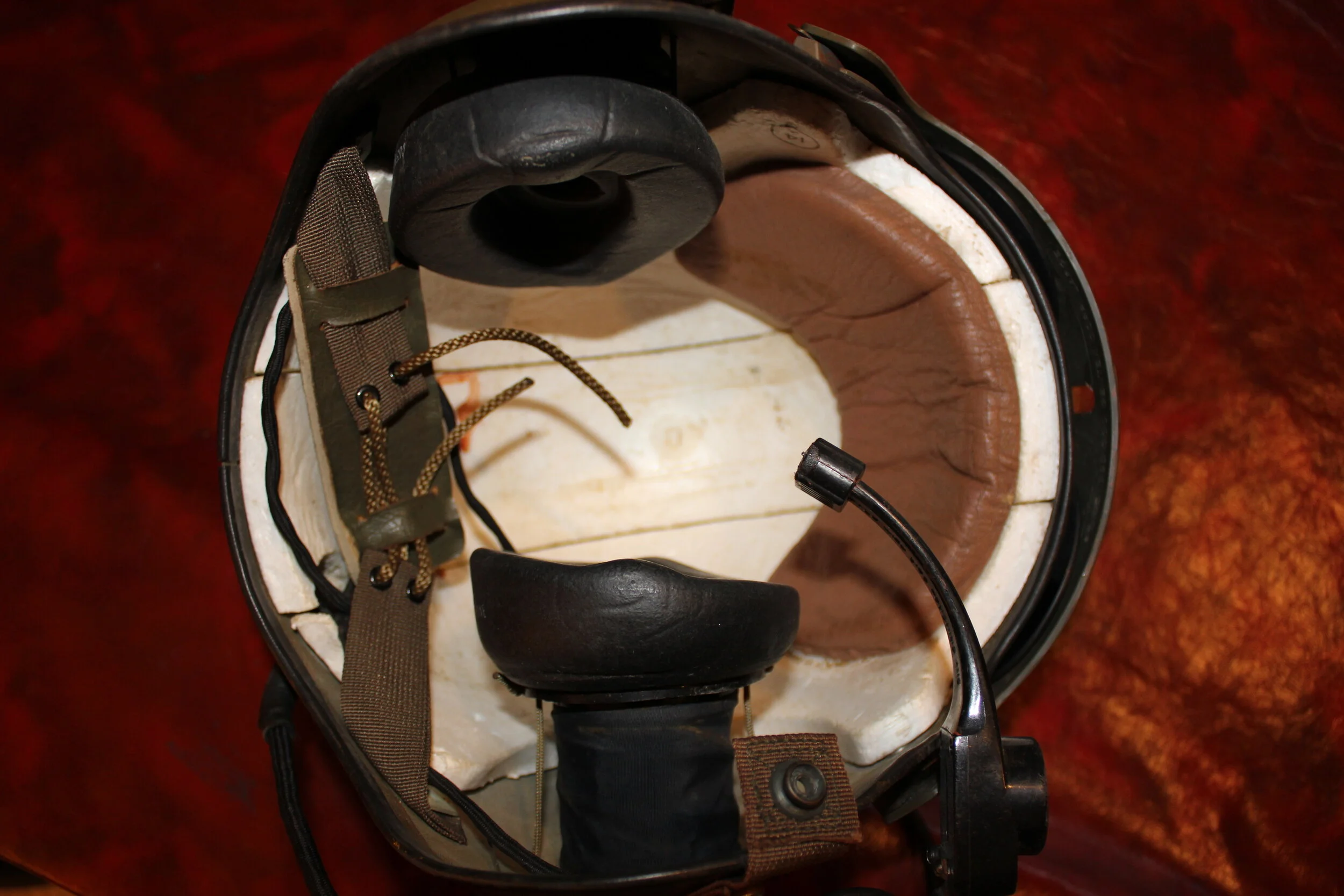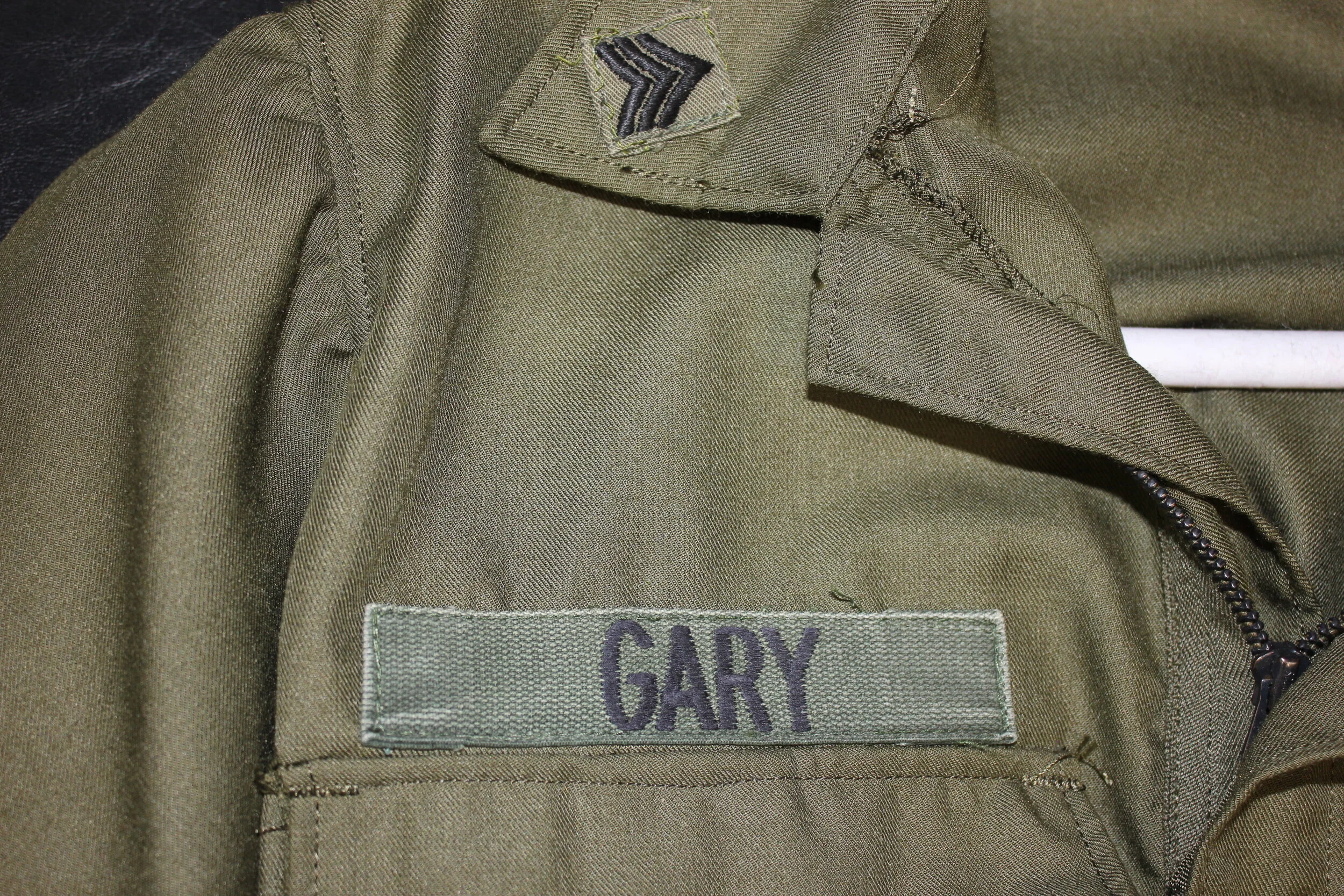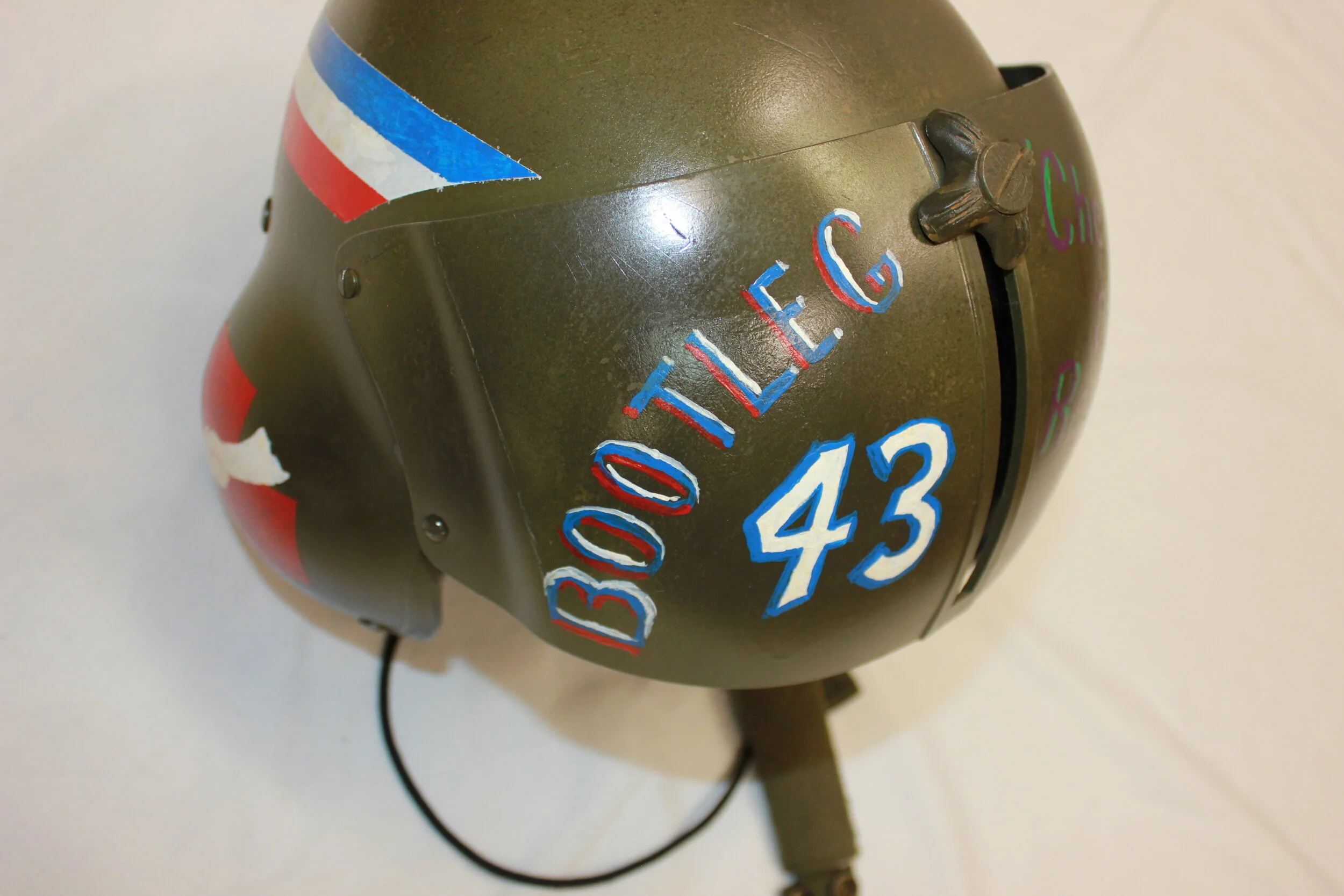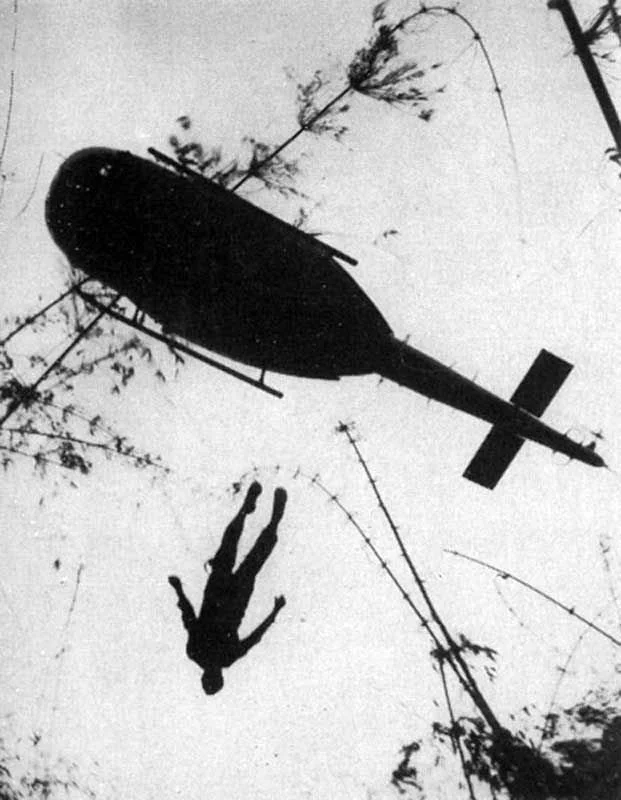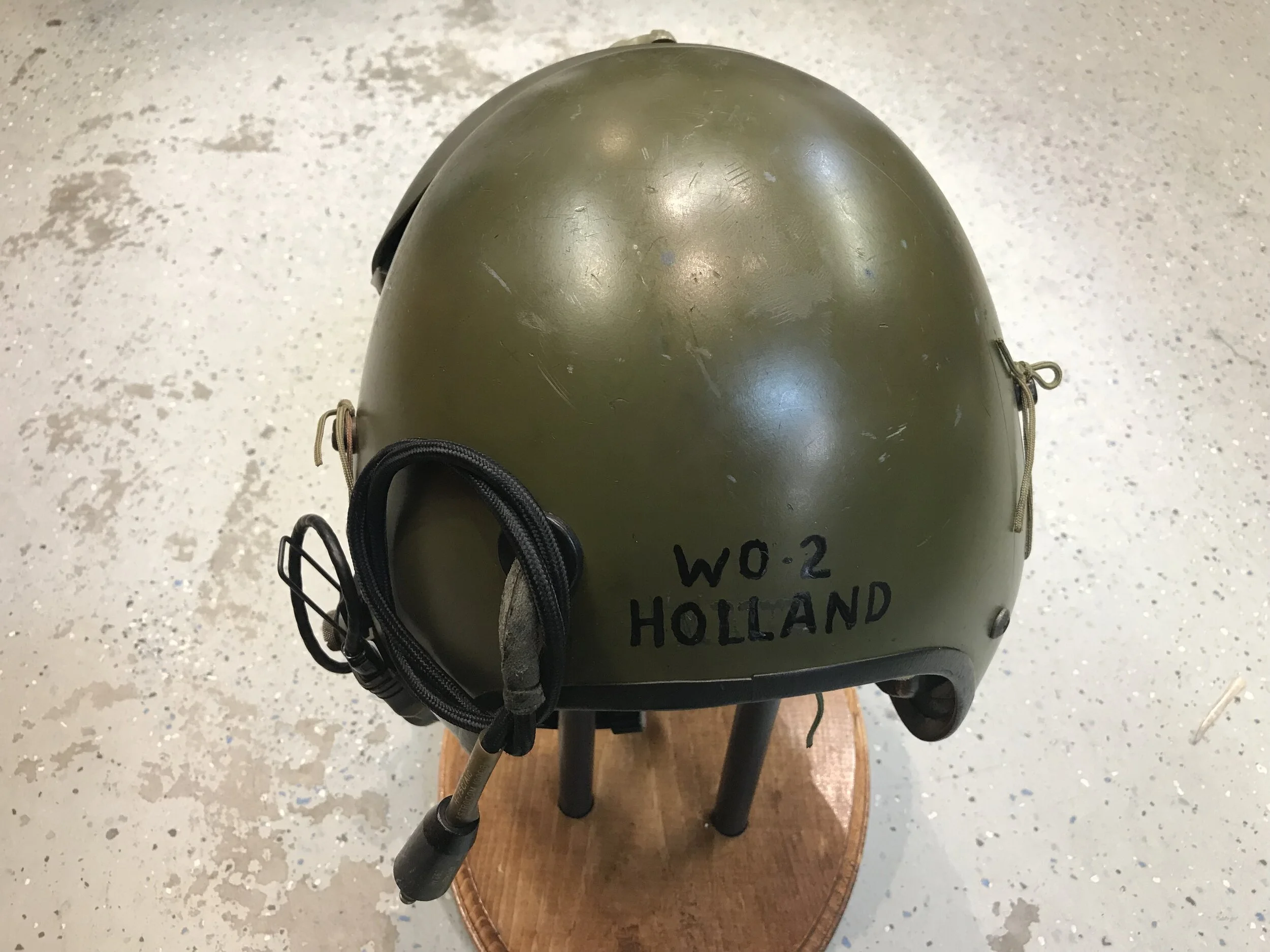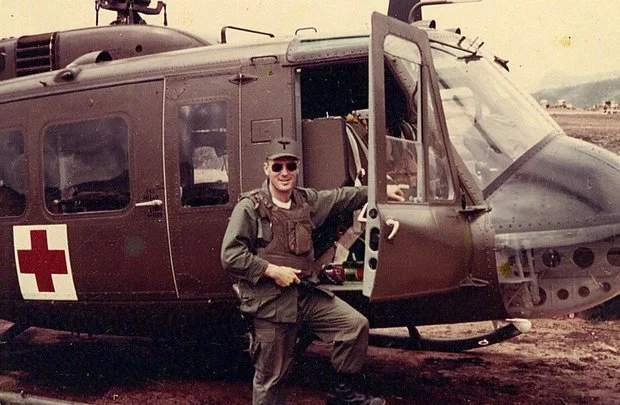Part #2, Air-Ambulance / Dust-Off 'MEDIVAC' Crewmen:
Captain, 377th Medical Detachment :
The US Army’s 377th Medical Company was one of the groups used in the “DUSTOFF” sense of the term, which is an acronym for the Medical Evacuation Helicopter, Air-Medics, if you will, and a very special bunch of talented and dedicated soldiers. In the medical evacuation service, Pilots, and Air-crew with medically trained personnel were responsible for evacuating the wounded soldiers from the battlefield and thus transporting them to medical facilities quickly for their treatment.
The 377th Medical Company, for the most part, was located in Pleiku in the Central Highlands. They flew in the “UH-1 Iroquois” but were referred to as the “HUEY” helicopter, just like most of the helicopters in the country. These Hueys, though, were specially modified medical evacuation aircraft, with a layer-litter system where the patients lay prone one above the other; they carried extra equipment such as stretchers, general medical supplies, and specialized medical personnel on board. I have not been able to nail down dates, and the uniform is a bit of guess and by-golly, but it represents that early time when the United States was pondering on just how involved it wanted to get in this conflict, and how much more were we willing to commit it it. But if I have the patches and it all buggered up, I apologize here now, it’s just something I can do for you Veterans. Everyone loves the good Doctor and his Driver.
The uniform depicts a very early period of the US involvement in the conflict, perhaps even before we admitted to even being there, as is often the case with the US News, a lot was going on there before the “official deployment” we saw on the TV-News in 1965. And the uniform Korean-War style, of 1950s stock, he wears The “Coffee Can” Ranger Cap, which was old school by then, and soon phased out altogether. The Helmets would also change, and soon the bright-white was replaced with OD paint. The 377th Medical Company was one of the most decorated units of the Vietnam War, receiving numerous awards and commendations for its service, including the Presidential Unit Citation, the Meritorious Unit Commendation, and the Republic of Vietnam Gallantry Cross with Palm.
Spec. 5, 45 Air Ambulance:
In late May 1967, the 45th Medical Company (Air Ambulance), located at Fort Bragg, North Carolina, was informed they were destined to go to Vietnam. It had been on deferred status since 1965, with twenty-five obsolete H-19 helicopters. Short 12 pilots, then ended up deploying without them (basically a full platoon). They were elated to find out they would be issued twenty-five new UH-1H Helicopter-Ambulances with Lycoming L-13 engines. They were located at Long Binh, Northeast of Saigon. The new aircraft could be fitted with hoists for in-flight hoisting-up litters by cable on a winch for loading wounded troops, they also had DECCA navigational kits installed, a pretty handy item. It wasn’t till 1967 that the 45th was fully operational. The 45th soon committed itself to give twenty-four-hour standbys at several bases around Saigon. One aircraft also gave daylight support to the Australians in the Saigon area.
Their aircraft were constantly getting knocked out of commission; their glossy paint and bright white paint with Red Cross markings marking them, made for easy targets, and they were completely unarmed! And they were being used by the 93rd Evacuation Hospital, the common mission was transferring many patients to the casualty staging facility near Tan Son Nhut. But the job was always to get the wounded soldiers to the Medics and doctors. The company was inactivated in Vietnam on 30 April 1971.
His uniform depicts a later model of the jungle jacket, made for the tropical weather in Vietnam, and the Jungle environment, which was the idea anyway. So by this time, these were getting to the field, fully subdued insignia format had been adapted for use in-country, as we see it, but his unit pocket patch retains the full color, but this was a common practice throughout the war.
The front and back of this flight medic’s helmet have received a lot of attention. Perhaps while on the ship taking him to the War, he had time to get it painted up; someone had an artistic hand to create the personalized marking, popularly attached to flyers from the very concept in the First World War. He’s chosen a wing with a re-cross in the center shield, and wings on the back with the Medical Branch emblem in the center. He had matching trousers and black boots. While these aircraft, did receive OD-Green paint, and smaller markings eventually, they still did not have the M-60 side guns of the Huey Slicks, so it was not uncommon for the crew to still have their M-16s or AR-15s with them, stuffed behind the pilot’s seats were sometime M-79 grenade launchers or M-1 Carbine with them as it was also common that they would be shot down, and if they survived the crash they wanted a chance to get to another helicopter. If they had a hard time getting patients out of Triple Canopy or Elephant Grass, in a hostile situation, they might throw out Blood Plasma, Aid Kits, sometimes extra ammunition bandoliers, or even weapons down to the troops needing help.
Specialist, 45 Air Ambulance, Air Crew/Medic (91B-Air Ambulance Aidman):
Here we have another example of one of these Fight-Medics, they would treat the wounded, assist in transferring patients, make a quick assessment of what they were dealing with, and tell the pilot, and he would decide what hospital and where. prep them for triage at the medical facilities in Vietnam. They provided medical aid to the civilian locals, the ARVN, and other Allied Forces, even at times, to enemy soldiers. While often supported with Gunship assistance, one could count the odds, and that was that the enemy was watching and waiting. Major Patrick H. Brady, Medical Service Corps, while flying with the 54th, earned the Medal of Honor.
If they could not get out their wounded, sometimes they brought extra medical kits or extra bandoliers of ammunition for their weapons and came back later. The uniform, a jungle fatigue jacket and regulation specs, but uses some in-country acquired insignia, all fully subdued though. His helmet never received any fancy paint job, so it is completely stock too, but kept emasculate, his hat he wears when not in the helmet, and he has a Cowboy style Vietnam Boonie cap, which was bought locally.
WO-2. 54th Helicopter-Ambulance Company:
This example of one of the crewmen, of a 54 th-A/C. A pilot who has acquired a set of Air Force-type flight skills, a gift from one of the Air Force airmen, he got out of a jam more than likely.
57th Med. Det. Helicopter Ambulance, Spec. 5, Dust-Off Crewman:
“Dust Off” was the technical call sign for pretty much all medical evacuation missions, first being used in 1963 by Major Lloyd E. Spencer, Commander US. Army 57th Medical Detachment (Helicopter Ambulance). The name would last throughout the rest of the war. Typically, Air Ambulances transported wounded soldiers categorized as “Urgent” patients from the point of injury to the nearest Medical Facility (Depending on Wounds) but there was the ‘Critical Hour’ theory in saving lives, so they had up to an hour to get them where they needed to be.
Flying into an active landing zone to pick up wounded soldiers was a very dangerous job. Peter Dorland and James Nanney wrote in “Dust-Off”: Army Aeromedical Evacuation in Vietnam, … slightly more than a third of the aviators on these aircraft became casualties in their work, and the crew chiefs and medics who accompanied them had similar statistics. The danger of the work was further borne out by the high rate of ambulance aircraft losses to hostile fire (Against the Geneva Convention to shoot at these aircraft, mind you), 3.3 times that of all other forms of Helicopter missions in the Vietnam War.
The 57th Medical Company (Air Ambulance) was originally consisted of the 57th Malaria Control Unit in September 1943 and activated as the Army Service Forces Training Center, New Orleans, LA, on 19, September 19, 1943. The unit was reorganized and re-designated as the 57th Malaria Control Detachment 08 April 1945 and then inactivated on 30 September 1945 in Brazil. The unit was reactivated and allotted to the Regular Army on 23 March 1953, designated the 57th Medical Detachment (RA), and assigned to Brooke Army Medical Center, Fort Sam Houston, TX.
The unit was the first Aeromedical Evacuation unit deployed to the Republic of Vietnam, arriving in-country on 26 April 1962 and remaining till de-activated at Tan Son Nhut Air Base, on 14 March 1973. During the 57th Medical Detachment’s Service in Vietnam, the units dedicated unhesitating service to the fighting forces, combined with an excellent medical support system, contributed to the lowest mortality rate for the United States Armed Forces of any conflict in history. The period of service in Vietnam also provided the 57th Medical Detachment (RA) with its ‘Motto’ “THE ORIGINAL DUST OFF” when ‘ALL’ aeromedical evacuations became known by the 57th Medical Detachment’s original radio call sign “DUSTOFF”. When the 57th Medical Detachment (RA) was sent to Vietnam, it became the first unit to use the UH-1 helicopters for MEDEVAC in actual combat operations, evacuating more than 100,000 patients within the combat zone. On 29 March 1973, the Detachment returned to the continental United States, getting assigned to Fort Bragg, NC.
Specialist 5 “DOC” McDaniel wears the first pattern of jungle fatigue with exposed buttons and full-color insignia. His 57th unit patch is attached to the Right pocket. His helmet has a Red Cross symbol front and back to identify him as medical personnel. This was supposed to keep him from drawing enemy fire, as under the Geneva Convention, he should be safe to render aid. But of course, as per norms, the enemy never looked at the rule book. So the early white-painted helicopters with big red crosses on them became clear targets for the VC and later NVA, and the crews soon resorted to green aircraft and the smallest crosses they were allowed to have. These crews felt like they flew in bullet magnets, and in more than one way, they were.
“NEW” Corperol/ Medic, 82nd Med. Det. RVN:
I’ll put together a story for this uniform soon.
159th Medical Detachment ‘Dust Off’, Cu Chi, Hau Nghia Province, III Corps, South Vietnam, Jan 1969:
An article in the Stars & Stripes, 27 Jan 1969, mentioned:
A call is received in the radio shack of the 159th Med Det. A field unit needs a medical evacuation helicopter - a dust-off chopper. 1:14 p.m. The chopper lifts off the pad at the 159th on its way to the coordinates given during radio contact. 1:21 p.m.: The dust off identifies the smoke marking the area and sets down in a clearing that moments before had been the scene of a fierce firefight. 1:23 p.m.: The chopper lifts off with eight patients aboard. 1:30 p.m.: The dust off shuts down at the 25th Med Bn back at the 25th Inf Div Cu Chi base camp. Within 20 minutes from the time the unit in the field radioed for its dust off, the wounded were receiving professional medical treatment in hospital conditions.
The efficiency of the 159th Med Det's team does not come easily. There is always a crew on "First Up" status ready to move out at a moment's notice. And that crew (aircraft commander, pilot, medic, and crew chief) is always a highly trained team of professionals. When the field unit calls the 159th's radio shack, coordinates are given along with the frequency and call sign of the ground unit. The crew is informed about the security of the area and how the area will be marked. Hopefully, information concerning the number of wounded and the type of injuries will be available. But the dust-off crew must be prepared for anything. During the dust off, teamwork is the keyword. The crew chief, whose job is to make sure the helicopter is in top shape, often becomes an assistant medic when patients are loaded onto the chopper. Sometimes, split-second adjustments must be made to accommodate more than the four stretchers and four ambulatory patients the shopper is equipped to carry.
Usually, no more than two or three minutes are spent loading the wounded onto the chopper. Then the dust off must lift its heavy load quickly. Because the load is heavy and the mission is vital, the dust off chopper has more horsepower than a gunship slick. During the flight to the 25th Med Bn, the medic usually has his hands full treating the wounded. Again, the crew chief acted in the capacity of an assistant medical man. When the chopper shuts off at the battalion, the wounded are immediately given medical treatment. The crew then returns to wait at the 159th for the next radio call that could come anytime.
Richard Lee Petty was nicknamed “The King” and was an American former NASCAR driver who raced from 1958 to 1992 in the former NASCAR Grand National and Winston Cup Series. He was the first driver to win the NASCAR Cup Championship seven times, winning a record 200 races during his career. Statistically, he is the most accomplished driver in the history of the sport and is one of the most respected figures in motorsports as a whole.
During the 1969 season, Petty drove a Ford Grand Torino painted in his established blue with the number 43. In 1970, he returned to Plymouth in the sleek new Plymouth Superbird with a shark nose and a towel rack spoiler wing. This is the car in which Petty is cast in the Pixar film Cars, in which Richard and Lynda Petty had voice roles.
for their aircraft
‘Cheatin’ the Reaper’ may well be the nose art of the aircraft alluding to the speed in which the crew buys the wounded as much of the medical ‘golden hour’ they can as they race them to the field hospital.
The ‘Bootleg 43’ call sign may hypothetically harken back to the crew’s southern legacy of American-made stock sedans, motors heavily modified, outrunning the local ’revenuers’ down the back roads of their home county.
Decorated a lot like Petty’s stock car, this helmet is a tribute to the genius of the aircraft. Originally designed as an air ambulance, HU-1, produced by Bell Aircraft, the nomenclature was flipped to UH-1, which gave it the slang name ‘Huey’. Initially underpowered,the later model combat air ambulance like ‘Cheatin’ the Reaper’, was powered by a Lycoming 1400 shaft horsepower turbine engine. The power-to-weight ratio of the aircraft was well known, referred to as being ‘able to fall up as fast as down.’
Both Bell & Lycoming have ‘sponsorship logos’ on the helmet. As a stock car, the bird’s raw horsepower is shown for bragging rights.
Like any racing team, the home stable is recognized in the Petty-inspired ‘159’ on the back and on the front with the iconic ‘43’. The detachments ‘hand up’ logo on the red cross is displayed on the right or military senior side of the helmet.
498th. Air Ambulance. Specialist:
The 498th Medical Company was activated on 23 September 1964. As a new Air Ambulance company, they were assigned to Fort Sam Houston, Texas, before they were deployed to the Republic of Vietnam in 1965, where it was assigned to USARV. They were operating in the II Corps Tactical Zone. They were then reassigned to the 43rd Medical Group, 1st Logistical Command in September 1965. The 1st major engagement they were involved in was a major attack on the Special Forces camp at PLEIME on 19 October 1965.
It was just a prelude to the Vietcong plan to cut South Vietnam in half. I’m not finding their story and missing a lot of operations during the Tet Offensive and the like. in the end of their time in Vietnam, they were the 498th Medical Co. (AA) 61st Med BN. in the 1970-71 period, located in An San. They returned to the United States in October 1971 and relocated to Fort Jackson, SC, then Fort Stewart, GA, and Fort Benning, GA. where they remain.
This flight jacket shows something different for a change, having the flying assignment they rightfully could be issued them, probably stateside, or even bought in the PX. but the insulated jacket was rarely needed in Vietnam, except in maybe the monsoon rain season, or up in the monotonous areas. It is however-the the Air Force type of jacket, but it is seen in photos, though there missing at the moment!? So I’m going with it, it shows this type of jacket too. However, the insignia is also applied unusually, in an Air Force way, maybe.
(WO-2) Pilot, 1st Cavalry Division, “Medivac”:
The “Cav” had their own Medivac unit as well, and this Warrant Officer represents a Pilot for the 1st Cavalry Division’s 15th Medical Battalion, they had also adopted the term “So That Others May Live,” and they served in Vietnam from 1956 to 1971.
The Platoon's aircraft arrived at Qui Nhon harbor in Vietnam on 12 September 1965, where the first two were flown to An Khe on that date. The first medical evacuation mission was flown the next day. The main body and the remainder of the aircraft arrived two weeks later on 25 September.
Originally, they had been using the call sign of "Mercy" flight so and so about their mission as "Angels of Mercy”, but within the year, they were being called “Medivac” from the teem Medical Evacuation.
Unlike most of the other Medivac units, they did end up adding modified machine gun mounts to the sides of many of their aircraft. They blended into a group if operating as so, and let’s face it, the enemy did not care for the Geneva Convention Rules, nor any other morals of the sort. Americans were the enemy, period, and they were targets of opportunity, obviously. People and aircraft were expensive, and it took time to train and get people to fly on medical helicopters.
Their aircraft arrived at Qui Nhon harbor on 12 September 1965, and the platoon began moving to An Khe. The next day, a medical evacuation mission was flown. It took till 25 September for all of the aircraft to arrive. So they sent up Camp Radcliff, An Khe, calling home the Golf Course. They would fight much of their war from there, and the unit earned many decorations as well as the air crewmen.
Their unit awards were: The Presidential Unit Citation for Pleiku Province, the Valorous Unit Award for Vietnam 1969, and Fish Hook. and the Meritorious Unit Commendation for service in Vietnam 1967-68, 1968-69, 1970-71, the Republic of Vietnam Cross of Gallantry with Palm for Vietnam 1965-69, 1969-70, 1970-71, and the Republic of Vietnam Civic Action Honor Medal, First Class for 1969-70. The 1st Cavalry Division itself has its story and I have that in another section.
The uniform is a basic fatigue shirt. The Mint-Conditian Flight Helmet has been personalized pretty nice, and kept in the bag when not in use. He would have had fatigue trousers and Infantymans boots, and he would have been issued a Flack Vest with its ceramic plate.
That Others Might Live:
I just wanted to make a note that there were other Medivac Operations that are noted here in the section, I don’t have enough Uniforms, Helmets, or information on other outfits, to show you anymore, but realize this, all Medivac, Dust-Off, and Lift Ships that came and got the wounded, many participated in that War, saved lives, many lives, and they did an outstanding job under horrendous conditions, I think I can speak for any veteran, that they respected and loved their medics, and those who manned the helicopters, that took them back to their camps or hospitals.









